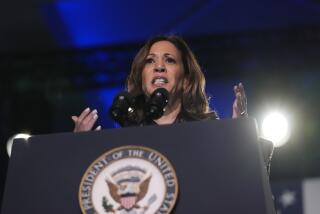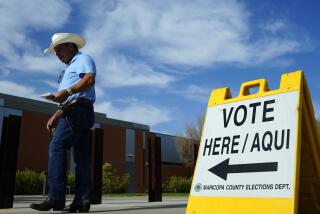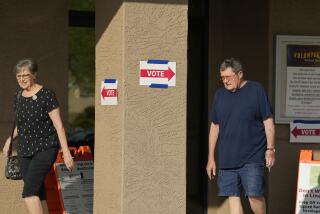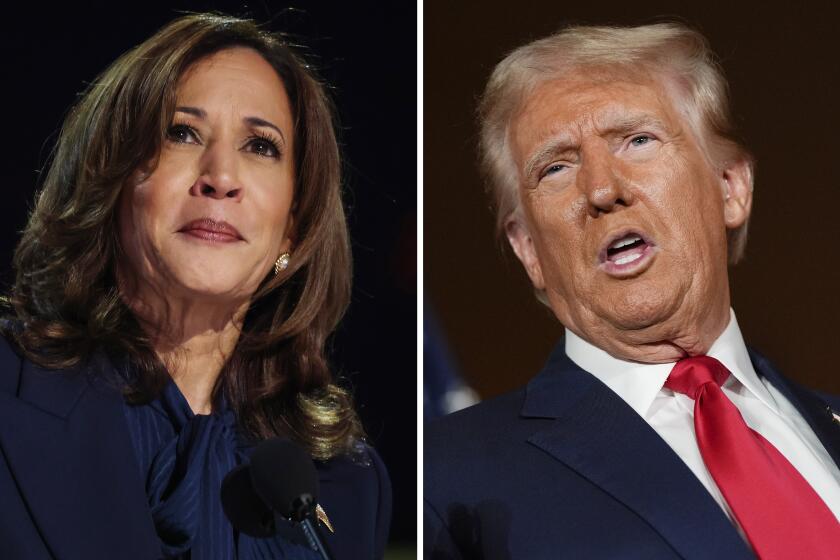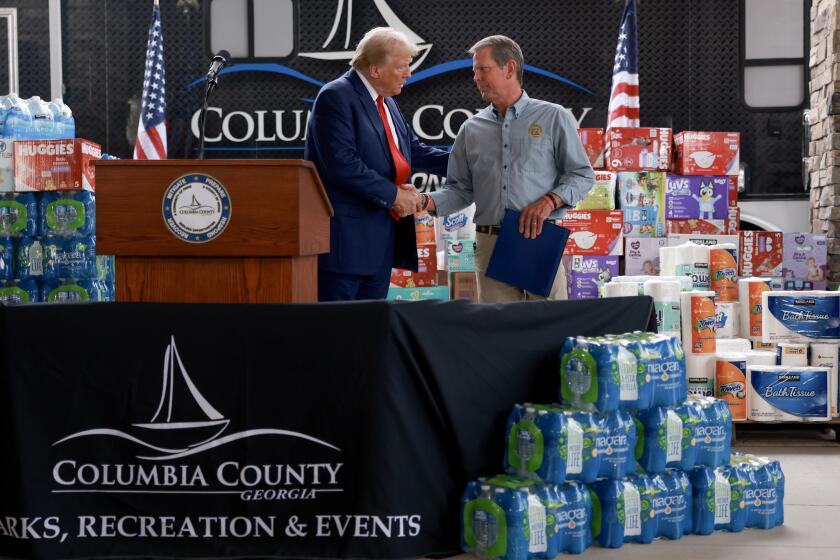
- Indigenous people make up 6% of Arizona’s population.
- The Native American vote could be pivotal in the state Biden won in 2020 by just 10,457 votes.
- This year marks the 100th anniversary of the Indian Citizenship Act, which gave Indigenous people U.S. citizenship.
On a recent sweltering Saturday in Phoenix, about 40 Native American leaders and community organizers gathered in an art gallery, where a backdrop had been decorated with posters proclaiming “Native Americans for Harris-Walz.”
Mark Kelly, Arizona’s Democratic senator, quickly assessed the audience. Anybody undecided? Silence. Everyone planning to vote in November? Hands shot up. “Early!” one woman shouted.
“Folks, this is not rocket science. If it were rocket science, I could help,” the former astronaut said, using his oft-repeated quip. “This election could come down to Arizona. And Arizona can come down to how many Native Americans show up to vote. All of you can be the difference.”
Across Arizona, Native American activists are gathering, rallying and registering their communities to vote with an urgent message — they could be the deciding factor in a whisker-thin election.

“We’re thinking today, but think for our future,” said Susanna Osife, 22. As Miss Gila River 2024, Osife is focused on registering young people to vote. “Our land, our water, our education, our healthcare. ... We have to make sure that all this is being kept safe for our community’s future.”

Democrats are pouring into Arizona to woo new and undecided voters in Native American communities by Monday, the last day to register. The U.S. census says Indigenous people comprise about 6% of the population, a sizable margin in a state where President Biden won by a mere 10,457 votes in the 2020 election — and history shows they swing Democrat.
Voting data analyzed by High Country News show that voters on tribal lands heavily supported Biden in 2020. Precincts in Navajo Nation ranged from 60% to 90% support for Biden, the analysis found, and some precincts in Tohono O’odham Nation reached 98%.
For some Indigenous activists, their political efforts aren’t just about electing Vice President Kamala Harris. The work comes at a significant time: 2024 marks the 100th anniversary of the Indian Citizenship Act, which gave Indigenous people U.S. citizenship. Arizona was still restricting their right to vote until 1948, when two Yavapai men sued over being denied ballots because they lived on a reservation, outside state boundaries.

For people like Allie Redhorse Young, it’s important to preserve that history.
“If there’s anything I know about our Native young people is our deep, deep reverence for our elders, our ancestors and our history,” said Young, a 34-year-old activist who rode her horse Lady Knight on a six-day trail ride across Navajo Nation to register people to vote.
She pointed to an Indigenous value passed through the generations — that “our actions today will impact the next seven generations.” So when she encounters young people wary about voting, because “this is not a system that was designed for us,” she agrees with them.
“But it’s the system that we live in,” said Young, who reminds young people about their responsibility to the next seven generations. “If you want to think about [voting] as a sacrifice, think about it that way. Our ancestors also had to make sacrifices. I know they didn’t want to sign those treaties, but our people were dying and their agenda was to exterminate us and to starve us out, and so our ancestors had to make those sacrifices and sign those treaties, even if they didn’t want to.”
Community festival, with a side of voter registration
As governor of the Gila River Indian Community, Stephen Roe Lewis keeps busy with his usual duties, launching new water projects and snapping photos with students at scholarship dinners. But lately, he’s been scrambling to organize voter registration events.
“A lot of these events are happening every day or every other day,” he said.

Registering Native Americans to vote can be tricky in Arizona, where some reservation dwellers don’t have physical addresses and many voters have to travel dozens of miles to cast their ballots. Arizona is also the only state to require proof of citizenship when registering to vote. For Indigenous people — particularly elders, who may have been born at home — citizenship papers can be hard to come by, though tribal IDs are sufficient.
High-profile Democrats are pouring in to help. National Democratic Party Chair Jaime Harrison spoke to the Gila River gathering. Interior Secretary Deb Haaland — the first Indigenous woman in a presidential cabinet and “the auntie of all aunties,” as one community leader put it — spent a recent weekend in Navajo Nation.
Registering people to vote works best when Indigenous people are doing the outreach, Lewis said.

“Especially for Native communities where we’re very unique, knowing the etiquette and the protocols … sometimes past campaigns have sort of misstepped,” Lewis said. “What I’ve seen is an amazing amount of coordination among all of the 22 tribes.”
One way to attract future voters, Lewis found, is to hold typical reservation events that draw crowds, complete with food, music and art. At a recent registration drive, more than 200 people gathered at the Gila River Multipurpose Center while a band on stage played a thumping rhythm.
A line of people snaked along one wall, waiting for trays of fry bread with beans and chili. While they waited, attendees helped themselves to “Indigenous Voter” hats and tote bags. In the center of the room, two artists painted on canvases; one painting featured the word “vote,” the V formed by two feathers held in the hand of an elder.
1

2

3

1. A get-out-the-vote event featured “Sky Vote” T-shirts for members of the Navajo Nation. 2. “Indigenous Voter” T-shirts for members of the Navajo Nation. 3. Artists paint on canvases during the voter registration event. One painting featured the words “Vote: Protect our Lands” (Photos by Faith E. Pinho / Los Angeles Times)
Kelly Whitman, the coordinator for Gila River events who planned the drive, first mined her own family for new voters. At a recent family dinner, Whitman asked her niece, Javonni Molina, 24, and her boyfriend, Justin Darrian, 24, if they were registered. Molina said her grandpa had taken her to register as soon as she turned 18, telling her, “You can’t complain if you don’t vote.” But Darrian wasn’t yet registered.
Molina brought him to the community center, where he sat at a table filling out the form as she and Whitman looked over his shoulder approvingly. Darrian pledged to vote in November, though he said he was “50/50” on which presidential candidate to pick.
“Oh, I’m so proud of you!” Whitman crowed. “I made one change today.”
He was one of 25 new voters registered at the event.
Getting people to register is one hurdle; getting them to vote is the next, and activists have seen their work pay off. Voters on Navajo and Hopi reservations cast nearly 60,000 ballots in 2020, compared with under 42,500 in 2016, according to an Associated Press analysis.
This year, Navajo Nation leaders voted to switch the date of its tribal elections to align with Arizona’s primaries. The goal of increasing turnout was clear in their resolution, “Arizona is a swing state, and the number of Navajo voters in the state is significant.”
One Native American candidate who prevailed in the July primary was Jonathan Nez, a former president of Navajo Nation who is running for Congress in Arizona’s 2nd District.

Some Indigenous voters are more inclined to cast ballots in local elections than state or national contests because they see the candidates at community events and may know them personally, said Rosetta Walker, a Maricopa County deputy registrar who frequently works to register young people.
College students in Phoenix “will drive 5½ hours to vote in their chapter elections, but they won’t fill out a ballot for the federal,” Walker said.
Local candidates, as well as issues, can drive voter turnout in November’s presidential race.

That’s the hope of Nez, who is running against Rep. Eli Crane, a Republican who made a name during his first term by joining other Freedom Caucus members to oust former California Rep. Kevin McCarthy as House speaker. If he wins, Nez would become Arizona’s first Indigenous member of Congress.
“I know that people think because of the presidential race, they’re going to help us,” Nez said of the Harris campaign. To him, it’s the other way around. “We’re actually helping them.”
More to Read
Get the L.A. Times Politics newsletter
Deeply reported insights into legislation, politics and policy from Sacramento, Washington and beyond. In your inbox three times per week.
You may occasionally receive promotional content from the Los Angeles Times.
